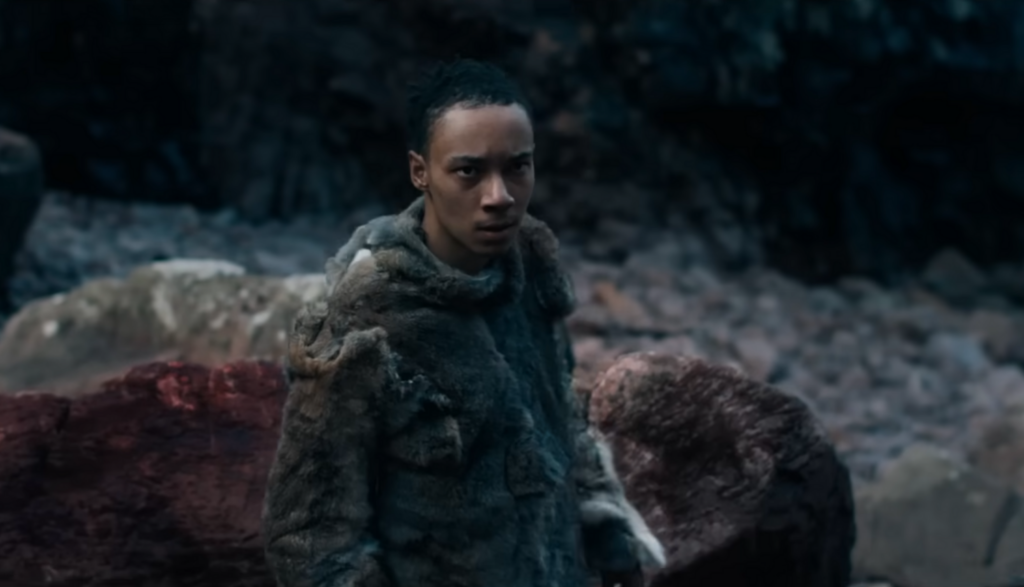
They left home for a better life—sailing west, to the land of myth.
But survival in the Stone Age is tough no matter where you go. So while they found land—much to their joy—it holds no milk, and it bears no honey. Its wind-whipped hills are filled with inedible tundra. Game is scarce, if it exists at all.
Adem, leader of this small family band, insists they’ll find food. But aged advisor Odal says that only demons live in this dark, cold land.
If the land be dark, Adem boasts, “then I am the light.”
“The danger in bringing light to a dark place is that you might find what lives in the darkness,” Odal says.
The rest of the band says little. They must trust Adem, all of them. They have no other choice.
Odal is old. Heron, Adem’s son, is still a child. Another is on its way, but its mother, Ave, would never survive on her own. Geirr, Adem’s younger brother, is a fine second spear, but he is no leader. And Beyah? She’s just a stray—allowed to tag along by the grace of Adem.
Yes, Adem may have led them across the waters and to their doom. But it’s too late to question his decision, too late to turn back. Their lives are in his hands.
But could Odal be right?
One day, Adem and Geirr discover the remains of an enormous beast—no meat, just tusks and hair and blood. Something killed the creature, but what? Adem tells Geirr to say nothing of their find. Adem needs to know more.
That night, as the small band huddles around a campfire, the thing strikes again—at the smallest of their company. Heron, the boy, vanishes. One minute his face is illuminated by the campfire. The next, he’s gone.
Adem wants to race into the darkness to find his son. Gierr begs him to stay until light. “I can’t do this on my own,” Gierr says, weeping. “If something happens to you.”
Adem sees it’s true. So he stays. But as soon as the light breaks, he’s up. The rest must follow. When Beyah tells Gierr that she will not go, Gierr simply says, “We have no choice.”
And so they go. All of them. Racing across the barren tundra. Racing toward the forest, dark and deep. There, their fates await them, be it doom or salvation.
There, the creature—or creatures—wait.
Morality in this Stone Age context looks starkly different from what we might recognize as such. Still, family counts for something here, and Adem very much wants to save his son from whatever terrible monsters might’ve taken him.
We also see hints of compassion and honor from an unexpected source.
Out of Darkness takes place in a time that significantly predates Christianity—around 43,000 B.C., according to press materials. And the “religion” that Adem’s group adheres to seems murky and formative.
Odal talks about demons and curses, and he advocates sacrificing someone to the thing that seems to be hunting them. Ave wears a necklace adorned with human teeth and beads shaped like babies—a talisman, it’s suggested, to protect the life growing inside her.
All of them seem open, at least, to the idea that their pursuer is supernatural. But they offer no prayers to God or gods; their spirituality, such as it is, seems deeply pragmatic. We do, however, see some funeral rites—honoring those who have passed on.
Beyah experiences her first menstrual period in this strange land (we see blood seep through her garment), and Ave tells her that it’s a “good thing for you.” As a “stray,” her status within the tribe is very tenuous. But Ave suggests that she now has greater value to Adem—given that she can now bear children, too. “You’re important to him now,” Ave says.
Along those same lines, Ave makes a very dark insinuation about her unborn child, too. “If my baby is a boy, I won’t worry,” she tells Beyah. “But if it’s a girl, she’ll have to earn her place.”
Ave says nothing further, but it seems as though she’s suggesting that girls in this formative earn their place solely through sex and motherhood—hinting that incest might be in play.
It’s clear that Ave has no real love or affection for Adem, even though she’s carrying his child. When he speaks to her, she responds fearfully and meekly. Certainly, if their “relationship” was set in the modern day, it would be certainly sniffed out as an abusive one.
As such, Ave’s words terrify Beyah, and she finds a weapon (a sharp stone blade of her own making) to protect herself should Adem force himself on her. Adem indeed tries: “You’re here for whatever I need,” he tells her one night, grabbing her by the hair. But before the scene goes any further, Heron is snatched—and the tiny tribe is far too busy trying to stay alive after that to think about anything else.
Trying to rescue Heron, Adem and the crew track his abductor to what appears to be the monster’s lair—a pit filled with blood and bones. They find what they assume to be the remains of the boy in the pit, but by then it’s getting dark, and the body count quickly goes up.
Someone is attacked and screams for help. When he’s “rescued,” it’s clearly too late for him. His jaw hangs limply from his face, apparently pulled partly off. In an effort to relieve his suffering, Beyah performs a mercy killing—hammering her knife into his chest. Soon after, most of the starving survivors cut up part of the dead man’s body—cooking it and eating it.
People are speared to death and smashed by rocks. Someone dies after being stabbed in the gut by what looks to be a small set of antlers. Another victim is pulled down—snapping his leg and sending a bone straight out of the skin. He screams for some time after. A character is knocked unconscious after hitting his head on a rock. Someone hacks away at someone else with a stone hatchet. A lair is set on fire. We see a number of graves.
The makers of Out of Darkness actually created a new language for the film, something they call Tola. But even in this new/old language, the speakers apparently still came up with the equivalent of the f-word, which shows up in the subtitles. (There’s no other profanity, though.)
None.
Someone vomits. People joke about eating members of their company—and, in case you missed it in the violent content section, those “jokes” eventually come true.
We don’t see a lot of Stone Age horror movies hit theaters. And while I can’t see that Out of Darkness will become part of a trend, the movie, for what it is, has its merits.
On the surface, Out of Darkness seems to be a monster movie—where a strange creature lurks at the edges of the fire in the folds of an inky black night; where towering trees become a cathedral of terror. But dig a little (with your painstakingly stone-carved tools, of course), and you’ll find that the film is as much about the monstrous tendencies inside the movie’s own characters—and, by extension, how those tendencies may lurk inside us. The story talks about hunger and fear and rage can lead us down terrible paths, and how our understandable desire to live can kill us a bit, too.
That makes Out of Darkness more thoughtful, more probing, than your typical bloody monster movie. But, of course, that’s also the source of its biggest problems.
Out of Darkness is violent, gruesome and deeply disturbing at times. It shows us the stark brutality of living—and dying—in the Stone Age, a time before Moses’ law and Jesus’ grace, a time where folks were making the rules as they went along. Those rules were stark and simple: One, you survive any way you can. Two—if you’re strong enough—you take what you want (and whoever you want) from those weaker than you. There is no sense of justice here. You either live or you don’t. And if you don’t, you may die in some spectacularly brutal ways.
One of the most memorable scenes in Out of Darkness isn’t particularly frenetic or violent: It’s Beyah sitting by the fire. She’s staring with dead eyes at nothing, stoically chewing her dinner … the flesh of a fallen tribe member.
Out of Darkness? Hardly. This film takes you to the heart of it.


Paul Asay has been part of the Plugged In staff since 2007, watching and reviewing roughly 15 quintillion movies and television shows. He’s written for a number of other publications, too, including Time, The Washington Post and Christianity Today. The author of several books, Paul loves to find spirituality in unexpected places, including popular entertainment, and he loves all things superhero. His vices include James Bond films, Mountain Dew and terrible B-grade movies. He’s married, has two children and a neurotic dog, runs marathons on occasion and hopes to someday own his own tuxedo. Feel free to follow him on Twitter @AsayPaul.
Our weekly newsletter will keep you in the loop on the biggest things happening in entertainment and technology. Sign up today, and we’ll send you a chapter from the new Plugged In book, Becoming a Screen-Savvy Family, that focuses on how to implement a “screentime reset” in your family!